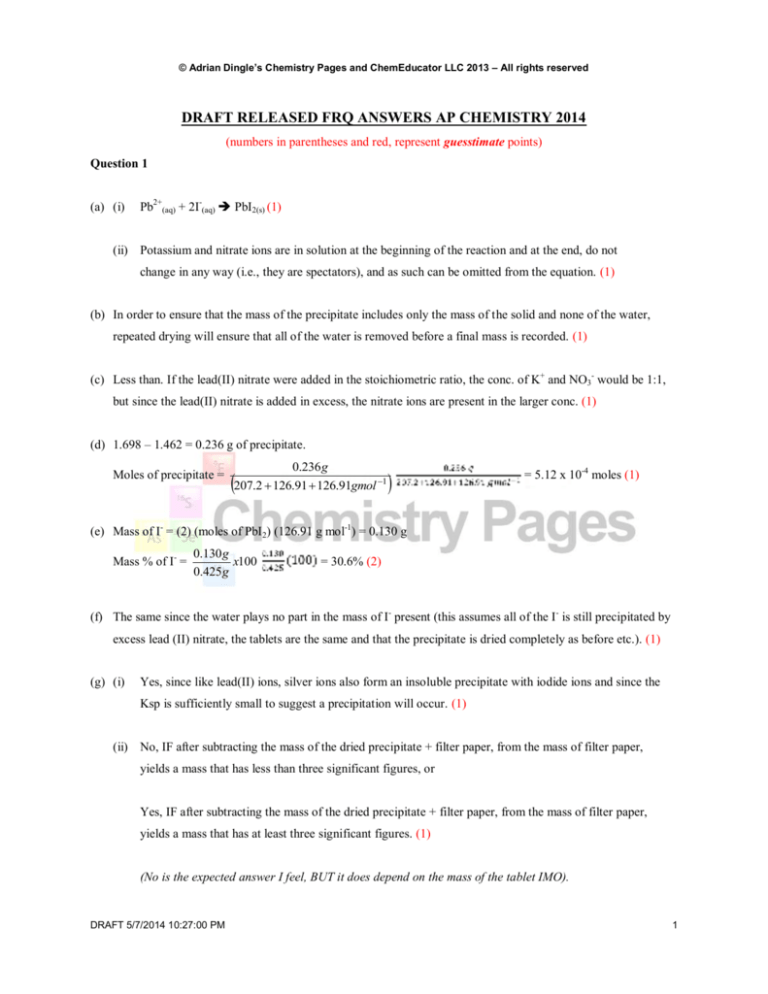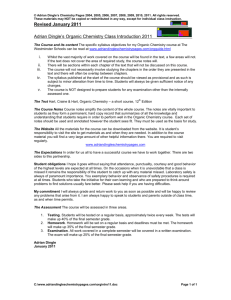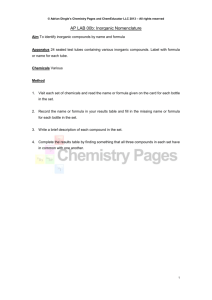
© Adrian Dingle’s Chemistry Pages and ChemEducator LLC 2013 – All rights reserved
DRAFT RELEASED FRQ ANSWERS AP CHEMISTRY 2014
(numbers in parentheses and red, represent guesstimate points)
Question 1
(a) (i)
Pb2+(aq) + 2I-(aq) PbI2(s) (1)
(ii) Potassium and nitrate ions are in solution at the beginning of the reaction and at the end, do not
change in any way (i.e., they are spectators), and as such can be omitted from the equation. (1)
(b) In order to ensure that the mass of the precipitate includes only the mass of the solid and none of the water,
repeated drying will ensure that all of the water is removed before a final mass is recorded. (1)
(c) Less than. If the lead(II) nitrate were added in the stoichiometric ratio, the conc. of K+ and NO3- would be 1:1,
but since the lead(II) nitrate is added in excess, the nitrate ions are present in the larger conc. (1)
(d) 1.698 – 1.462 = 0.236 g of precipitate.
Moles of precipitate =
0.236 g
207.2 126.91 126.91gmol 1
= 5.12 x 10-4 moles (1)
(e) Mass of I- = (2) (moles of PbI2) (126.91 g mol-1) = 0.130 g
Mass % of I- =
0.130 g
x100
0.425 g
= 30.6% (2)
(f) The same since the water plays no part in the mass of I- present (this assumes all of the I- is still precipitated by
excess lead (II) nitrate, the tablets are the same and that the precipitate is dried completely as before etc.). (1)
(g) (i)
Yes, since like lead(II) ions, silver ions also form an insoluble precipitate with iodide ions and since the
Ksp is sufficiently small to suggest a precipitation will occur. (1)
(ii) No, IF after subtracting the mass of the dried precipitate + filter paper, from the mass of filter paper,
yields a mass that has less than three significant figures, or
Yes, IF after subtracting the mass of the dried precipitate + filter paper, from the mass of filter paper,
yields a mass that has at least three significant figures. (1)
(No is the expected answer I feel, BUT it does depend on the mass of the tablet IMO).
DRAFT 5/7/2014 10:27:00 PM
1
© Adrian Dingle’s Chemistry Pages and ChemEducator LLC 2013 – All rights reserved
Question 2
(a) CH3CH2COOH (acid) and CH3CH2COO- (base)
or
H2O (base) and H3O+ (acid). (1)
(b) Ka =
= 1.3 x 10-5
Assumes degree of dissociation to be negligible. (2)
(c) (i) False. The salt that forms from the neutralization reaction is sodium propanoate that is the salt of a weak
acid and a strong base that will have a pH of greater than 7.00, due to the hydrolysis reaction of the
propanoate ions as shown below. (1)
CH3CH2COO- + H2O CH3CH2COOH + OH(ii) True. If the pH is same for both solutions, then the [H+] is the same for both solutions. Since HCl is 100%
dissociated and propanoic acid is not, the propanoic acid would need a higher initial concentration than the
HCl in order to generate the same [H+] in solution. (1)
(d) Moles of NaOH = (0.02052 L)(0.173 molL-1) = Moles of acid (since a 1:1 ratio)
Concentration of acid =
(0.02052 L)( 0.173molL1 )
0.02500 L
= 0.142 M (1)
(e) No. Ka for butanoic acid is 10-4.83 = 1.48 x 10-5 so the acids are of very similar strength and as such the
same indicator would be suitable. (1)
DRAFT 5/7/2014 10:27:00 PM
2
© Adrian Dingle’s Chemistry Pages and ChemEducator LLC 2013 – All rights reserved
Question 3
(a) Oxidation occurs at the tin electrode since it loses mass as the solid dissolves into solution according to;
Sn(s) Sn2+(aq) + 2e-. (1)
(b) The solid dissolves to give an aqueous solution of tin ions. (1)
(c) (2)
K+
NO3-
(d) (i)
No change. The concentrations of both the product and reactant ions are still equal to one another
and their ratio is 1:1. There is no need for the reaction to shift forward or backward to adjust to the
equilibrium position (Q is unchanged). (2)
(ii) A shorter time. The new, lower concentration would be exhausted more quickly. (1)
(e) (i)
Sn(s) + Cu2+(aq) Cu(s) + Sn2+(aq)
Eo = +0.34 + (+0.14) = 0.48 V
i.e., a positive voltage that suggests a thermodynamically favored reaction. (2)
(ii) G = -n F Eo = -(2)(96485)(0.48) = -93000 J (1)
DRAFT 5/7/2014 10:27:00 PM
3
© Adrian Dingle’s Chemistry Pages and ChemEducator LLC 2013 – All rights reserved
Question 4
(a) P V = n R T
(1.04)(1.00) = n (0.08206)(1100)
n = 0.0115 moles (1)
(b) Disagree. The reaction is at equilibrium so there must be some CaCO 3(s) left in the container. (It is entirely
possible to answer this via stoichiometry, proving that if there was total decomposition, that the moles and
therefore the pressure of CO2, would be much greater). (1)
(c) Equal to, since if the temperature were to stay the same, the equilibrium constant would remain the same, and
since the only species in the K expression will be either the pressure or concentration of the CO 2, then it must be
the same. (1)
(d) Yes, since Kp = pCO2. (1)
DRAFT 5/7/2014 10:27:00 PM
4
© Adrian Dingle’s Chemistry Pages and ChemEducator LLC 2013 – All rights reserved
Question 5
(a) ClF. (1)
(b) (1)
(b) T-shaped. In this configuration the dipoles created by the polar Cl-F bonds do not cancel out and the molecule
has a dipole moment. In the trigonal planar configuration the dipoles would cancel out and the molecule would
be non-polar. (2)
(d) As group 17 is descended the halogens become increasing able to expand their octets, and accommodate more
fluorine atoms, since steric hindrance becomes an increasingly small problem. (1)
(There are many alternative responses here and we will have to wait and see what scores credit).
DRAFT 5/7/2014 10:27:00 PM
5
© Adrian Dingle’s Chemistry Pages and ChemEducator LLC 2013 – All rights reserved
Question 6
(a) PVC, since Cl has a greater mass than CH3. (1)
(b) The IMF’s present in chloroethene are larger than those in propene.
Chloroethene is polar and has dipole-dipole intermolecular forces whereas propene is essentially a non-polar
hydrocarbon. Cl is a larger atom than the CH3 group, with a greater number of electrons and has greater
polarizability and hence a greater number of LDF’s and stronger intermolecular attractions that cause the
boiling point to be higher. (2)
(c)
2C3H6 6C + 6H2
H = (2)(-21)
6C + 6O2 6CO2
H = (6)(-242)
6H2 + 3O2 6H2O
H = (6)(-394)
=======================================
2C3H6 + 9O2 6CO2 + 6H2O
H = -3858 kJ
Which is a greater release of energy than -2300 kJ. (2)
DRAFT 5/7/2014 10:27:00 PM
6
© Adrian Dingle’s Chemistry Pages and ChemEducator LLC 2013 – All rights reserved
Question 7
(a) In the first two experiments, run with differing initial concentrations of cis-but-2-ene, there is a constant halflife. (1)
(b) t½ =
0.693
= 100 sec
k
k = 0.00693 sec-1. (1)
(c) Less than, since in trial 1 the change in cis-but-2-ene is 150 torr per 100 seconds and in trial 2 the rate is 300
torr per 100 seconds. (1)
(d) At a higher temperature the reaction rate is faster since the average energy of the particles in increased and the
number of particles that posses the minimum required energy (the activation energy), increases. (2)
DRAFT 5/7/2014 10:27:00 PM
7









